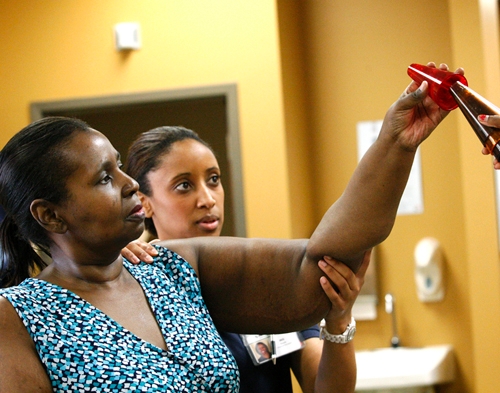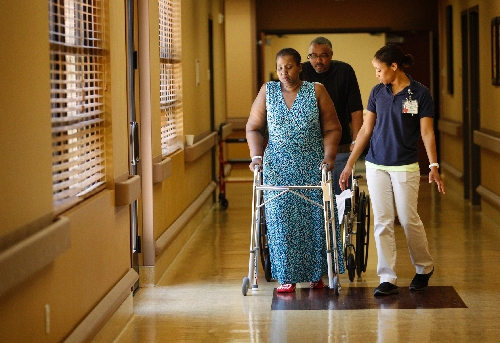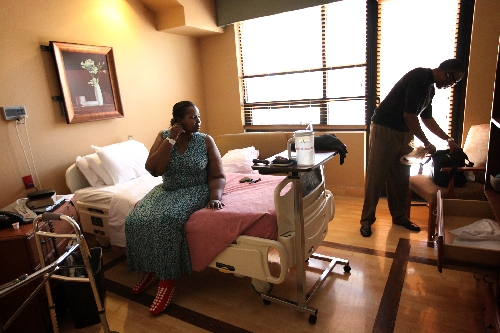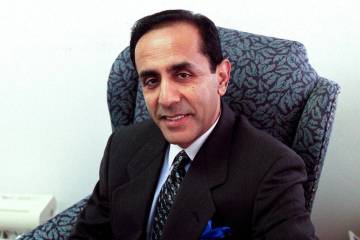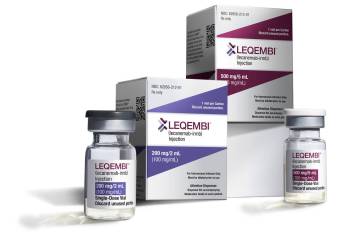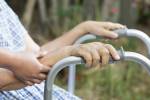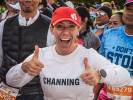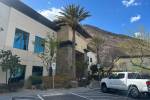Helped by doctors and family, Las Vegas stroke victim works to recover
Summerlin resident Nathnie Gibson woke up one morning in June to find her life turned upside-down.
"I couldn't move my hand. I went to grab my cup of tea, and my hand dropped down - I couldn't keep it up," said Gibson, 48, a former human resources manager. " My husband walked in the door, and he looked at me and goes, 'What's wrong?' "
Her husband, Bill Gibson, had an inkling that it could be a stroke, because both of Nathnie Gibson's parents had died of strokes.
"I had her do some simple tests that would reveal whether she had a stroke or a seizure. I ran to the box of knowledge called Google, and I Googled it. And it said have the person do simple things like raise their hand, move their eyes, do things like that. I saw she wasn't able to, and so I told her: 'You're either having a stroke or you had a stroke. We need to get you up to a hospital and we have to go right now,' " he recalled.
Within four or five minutes, they arrived at Summerlin Hospital Medical Center, and Nathnie Gibson, who also suffers from lupus and fibromyalgia, was rushed to the emergency room and given the clot-busting drug known as tPA.
" They took me straight back. I started losing my functions. I couldn't walk. I don't remember a lot about while we were at Summerlin Hospital. I was there for two days, and then they shipped me over here to rehabilitate," Nathnie Gibson said during a recent interview in her room at the HealthSouth Desert Canyon Rehabilitation Hospital.
Nathnie Gibson's experience is not that uncommon. Nearly 800,000 Americans suffer a stroke each year, and about one-quarter of those are repeat strokes. In the United States, stroke is the fourth-leading cause of death, killing more than 133,000 people each year, according to the National Stroke Association. It also is a leading cause of serious, long-term adult disability. One occurs every 40 seconds, and one person dies of stroke every four minutes, the association says.
REACTIONS TO STROKES VARY
There are two types of stroke: ischemic and hemorrhagic.
Ischemic stroke occurs when arteries are blocked by blood clots or by the gradual buildup of plaque and other fatty deposits. Most strokes - approximately 87 percent - are ischemic.
Hemorrhagic stroke occurs when a blood vessel in the brain bursts, leaking blood into the brain. These strokes account for approximately 13 percent of all strokes, but are responsible for more than 30 percent of all stroke deaths.
Most strokes - as many as 80 percent - are preventable, said Dr. Stephen P. Raps, who is a consultant for the private Silver State Neurology practice, and an associate professor of neurology for the University of Nevada School of Medicine. Strokes often are a consequence of other medical issues, such as smoking, obesity, diabetes and high cholesterol.
Raps said rehabilitation is required for most cases, but not all.
"It's not that unusual, however, for a patient who either has had a minor stroke, or who is successfully treated, to be discharged home directly from the hospital," he said.
For example, someone who has a small stroke may experience only minor problems such as weakness of an arm or leg. People who have larger strokes may be paralyzed on one side or lose their ability to speak. Some people recover completely from strokes, but more than two-thirds of survivors will have some type of disability.
There are an estimated 7 million stroke survivors older than 20 in the United States.
"It's not entirely clear why stroke incidence remains as high as it is," Raps said. "Part of it is aging. After the age of 50, the risk of stroke doubles every 10 years. People of that age will continue to have a higher incidence of stroke."
LIFE-CHANGING EXPERIENCE
Upon learning she had a stroke, Nathnie Gibson said fear became an overriding emotion.
" Both my parents had strokes that led to their deaths. I was afraid, and I didn't think that I was going to get all of my functions back because (at the time) I couldn't function. I hoped to God that he would allow me to start to do things, and that it wasn't fatal," she said.
" I'm a very independent person, so it's hard for me (to be in this situation)," Gibson said. "I don't even know how to explain it. It's like you're on the outside looking in at yourself, saying, 'This is not me.' "
In addition to problems moving her left hand, Nathnie Gibson experienced other issues, among them short-term memory loss, one side of the face drooping and slurred speech.
Gradually, as her rehabilitation continues, she is seeing progress.
A few days before her release from the rehabilitation center, Gibson reflected on her experience.
" It changed the quality of life for me. I have a lot deeper appreciation for things that we take for granted because to not be able to walk, to have to have people to shower you, it's uncomfortable, and it's a little scary," she said.
The Gibsons have five grown children, including two adopted sons, two daughters and a son. Their visits, and visits from other family members and friends, have helped Nathnie Gibson in her recovery.
"People are making rounds, coming to see me, such as my pastor and his wife, which is nice, and I think that encourages people, when you see people you love. It's really helped me, " she said.
Health professionals also say that such visits can aid in stroke victims' recovery.
Family members can support a stroke patient as the person progresses through therapy and strives to make changes to avoid another stroke, said Ceferino Villafuerte, director of therapy operations, at HealthSouth Desert Canyon Rehabilitation Hospital. "One of the best things in terms of outcomes is a supportive family," he said.
RECOVERY TAKES EFFORT
In many cases, much of the recovery of stroke victims occurs within six to eight weeks of the incident. When stroke patients arrive at the facility, the hospital assesses their status and determines the best course of therapy.
"Usually what we tell our patients is the gender, the size of the stroke, how they were prior to the stroke, how quickly they got assistance are good predictors of their recovery," he said. The hospital also uses standardized assessments and unique tests "that allow us to give some predictors of baseline recovery."
Patients, and their family members, usually want to know how long they will be in their current state, Villafuerte said.
" They don't know what to expect and we don't either," he said. "It's a cloud of where we expect them to be, and they can be anywhere in that cloud."
Stroke care involves helping patients to regain their strength, recover as much function as possible and return to independent living, according to MayoClinic.com. The impact of the stroke depends on the area of the brain involved and the amount of tissue damaged. If a stroke affected the brain's right side, movement and sensation on the left side of the body may be affected. If a stroke damaged the brain tissue on the left side of a brain, the movement and sensation on the right side of the body may be affected. Brain damage to the left side may result in speech and language problems. Other potential issues include problems with breathing, swallowing, balancing and vision.
Some patients may recover completely from a stroke, while others may not get full use of a limb or have lost other functions.
"We talk to them about the timelines, and that regardless of whether the limbs never recover, we still expect them to be able to function independently outside of the hospital, " Villafuerte said.
It may not be the way they envisioned, he said. For example, some might need assistive devices to walk.
HealthSouth also focuses on education about risks and how patients can control those risks. At its core, Villafuerte said, "it's actually just being active and eating right. If you can get the activity and nutrition levels appropriate, you can reduce (the risk). And obviously there's a medical regimen involved with it. You just need to talk to your physician about that, but the reality is once you've had a stroke you're more likely to have another one. You have to start managing those factors that are controllable."
Although her recovery will continue for some time, both Gibson and her husband say they are thankful for the progress she has made through the help of dedicated therapists and nursing staff at the rehabilitation hospital.
"This place has made a tremendous difference in helping her to recover," Bill Gibson said. "The people here are really, really patient."
Nathnie Gibson said. "The pace of progress can be frustrating. I'm the type of person that wants to do it now, now, now, now. I've got a little more distance to go, but it's OK."
Her physical therapist and nurse have provided a backbone of support that has helped her tremendously along the way, Nathnie Gibson said.
"They were great and went over and beyond the call of duty," she said.
They encouraged her to make the effort - that the hard work would pay off. "On the first day of therapy, my therapist told me, 'Either you don't do this and you stay the same way that you are, or you can do it and become healthier,' " Nathnie Gibson said.
That no-one-else-can-do-it-for-you moment helps motivate her during the often difficult and tiring sessions.
" It's very hard work. It's hard just to move my leg," said Gibson, who during her interview earlier this summer spoke slowly and a little haltingly. "I still can't lift my arm. I still can't lift it up like this (demonstrating with her unaffected arm), so it's hard. Like I said, I'm still going through it."
WORK CONTINUES AT HOME
The HealthSouth facility includes a state-of-the-art gym featuring the latest in therapy equipment and exercise machines, as well as areas set up like kitchens and laundry rooms, so patients can practice daily living skills. There is also a spalike meditation room, with trickling fountains, tranquil colors and soft lighting.
Depending on their needs, patients can receive physical therapy, speech therapy, respiratory therapy, occupational therapy, and diet and nutritional counseling. Patients also can attend a stroke support group offered every third Tuesday of the month.
A religious person, Nathnie Gibson said she also believes her faith and prayer have played an important role in recovery.
"I give glory and honor to my Lord Jesus Christ for the recovery I've had this far."
Although aware of the risk of stroke, its occurrence caught the couple off guard because both Nathnie and Bill Gibson were taking steps to avoid the problem.
"We pretty much followed the rules, so to make changes in our lives, there's not a whole lot different we can do, because we were already doing it," Bill Gibson said, noting Nathnie Gibson was following a well-balanced diet and heeding her doctors' advice.
What they will have to do is remain extravigilant about doing the right things to avoid another incident.
"The doctor came to talk to me. He said now that I've had one (stroke), I'm more susceptible to have another one. I have to be extra careful," Nathnie said.
After spending about two weeks at the rehabilitation hospital, Nathnie got the OK to go home. But returning home presented its own set of challenges. The Gibsons live in a two-story townhome, with bedrooms on the second floor. With Nathnie unable to climb stairs, the couple had to move a hospital bed into the townhome's living room. They are hoping to move to a single-story home that will offer fewer challenges as Nathnie works on her recovery.
Bill Gibson said he realizes the couple will have to make adjustments to accommodate her recovery process.
"I may even have to consider modifying my hours so I'm not away from her for so long. It truly depends on her recovery time," said Bill Gibson, an electronics technician.
He and his wife also are bracing for the bill for the treatment.
"I have insurance. I have good insurance, but I still have to pay 20 percent, so whatever that bill is, it's that wave that's coming," he said.
Nathnie Gibson said she hopes to raise awareness by talking about her ordeal.
"I just want to help somebody so they don't have to go through this because it's not fun," she said. "I would advise them (stroke patients) to take their physical therapy serious because that's where it's going to turn - that's what's going to determine where you're going to be after this ordeal."
Bill Gibson agreed that people need to raise awareness of stroke causes and warning signs.
"We take health for granted," he said. "Too many people get sick and then have to try to get healthy. When you maintain good health, you have it, so maintain a healthy diet and exercise if you can. Whatever you do, check your numbers. Keep an eye on your cholesterol, your blood sugar, stuff that we take for granted."
RAISING AWARENESS
Raps said he hopes to see even more progress made in public awareness of the stroke symptoms and the urgency of seeking immediate attention.
"I think there's a lot more work to be done on the preventive side. I think it's more important to prevent it than treat it," Raps said.
A "distressing number" of patients who are aware of the symptoms still choose not to go to the hospital immediately, out of fear or out of mistakenly believing the symptoms would go away, Raps said.
"The biggest barrier to treatment has been, and still is, not presenting early enough for treatment," he said.
While a three-hour window for administering the clot-busting drug tPA (tissue plasminogen activator) is the standard time frame, the American Stroke Association has upped its recommended time limit guideline to 4.5 hours after the initial appearance of symptoms for patients who don't have obvious exclusionary issues.
Some 8 percent to 10 percent of ischemic stroke victims arrive within the standard three-hour window to be treated with the drug.
"Many more could be (treated) if they get it within the window, " Raps said.
" To be honest, it's a pretty rewarding experience to be able to give the patient a clot-busting medicine and see them dramatically improve, and, in some cases, walk right out of the hospital."
Emergency treatment of hemorrhagic stroke victims focuses on controlling bleeding and reducing pressure in the brain. Surgery also may be employed to reduce future stroke risk.
Sometimes, before a full-blown stroke, patients may get a warning sign in the form of a transient ischemic attack, a TIA, or ministroke. These are caused by blood clots in arteries supplying the brain, and they usually dissolve within 24 hours before causing permanent damage. Patients whose ministroke symptoms are recognized can be given preventive treatment, according to the National Stroke Association. Besides lifestyle changes such as diet and exercise, a patient's doctor may recommend drugs to treat high blood pressure, high cholesterol or heart disease.
STROKE SYMPTOMS
Here are important signs of trouble:
• Sudden numbness or weakness of face, arm or leg - especially on one side.
• Sudden confusion, trouble speaking or understanding.
• Sudden trouble seeing in one or both eyes.
• Sudden trouble walking, dizziness, loss of balance or coordination.
• Sudden severe headache with no known cause.
An easy way to check whether someone may be having a stroke is to remember FAST:
Face: Ask the person to smile. Does one side of the face droop?
Arms: Ask the person to raise both arms. Does one arm drift downward?
Speech: Ask the person to repeat a simple phrase. Does the person's speech sound slurred or strange?
Time: If you observe any of these signs, call 911 immediately. Note the time when the first symptom was noticed. This is important because if given within three hours of the first symptom, an Food and Drug Administration-approved clot-buster medication known as tPA may reduce long-term disability for the most common type of stroke. There are also other types of stroke treatment available that might help reduce the effects of stroke.
SOURCE: National Stroke Association's website, stroke.org



